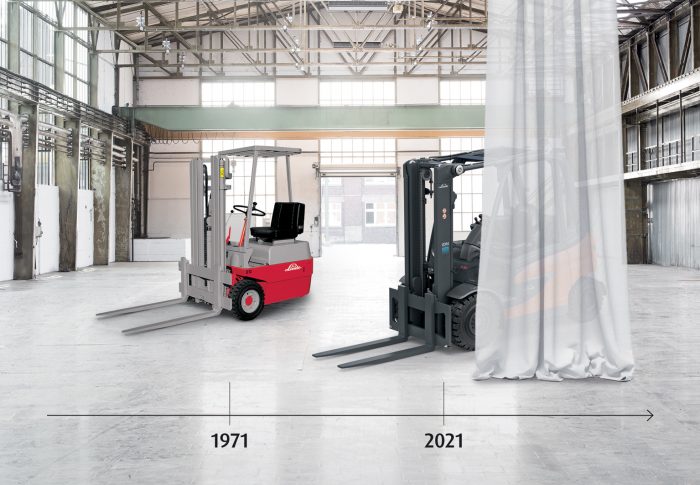Future carrier with a 50-year success story

The now 50-year success story began at the German industrial trade fair in Hanover in March 1971: Linde Material Handling (Linde MH) presented its first electric forklift truck. Since then, the goods handling specialist has left its mark on electromobility with many technical innovations and has advanced to become the European market leader in the electric counterbalanced truck segment. Now the next highlight is in the starting blocks: June will see the launch of a new generation that combines “the best of both worlds.” The electric forklift becomes the equal of the combustion engine.
“Looking back, it was a decision for the future,” says Stefan Prokosch, Senior Vice President Brand Management at Linde MH. “Today, we not only offer our customers a large portfolio of electric industrial trucks with various energy storage systems, but also use our know-how to electrify vehicles of all kinds – from hackney carriages to trolley cars.”
When the first Linde-branded forklift powered by electricity was launched in the early 1970s, the huge potential of electromobility was not yet foreseeable. Development was primarily aimed at offering a device for applications in enclosed halls. With the battery-powered forklift, Linde MH opened a new chapter in the company’s history, because the drive and energy storage system posed different technical challenges than the flagship: the Linde Hydrostat. Highlights of the first electric series in the payload range from 1 to 1.5 tons were the two-motor front drive, for turning maneuvers on the smallest radius, and the double-pedal control known from the hydrostat. This was intended to make it easier for operators to switch between the two types of drive. In the following years, the demand for electrically driven forklifts increased steadily. This was because the number of warehouses and distribution centers grew – and with it the need for emission-free equipment. At the same time, the demands on the noiseless and emission-free indoor trucks increased: customers wanted higher payloads, more handling capacity, and a greater number of variants to cover ever new areas of application in industry and trade.
Compact axle as a milestone in e-truck development
Further development of power electronics and digital technology paved the way for the continued success of electric forklifts from Linde MH. In 1999, the first model with a three-phase or asynchronous motor was added to the product portfolio. Engineers developed their own power and control modules for this new drive. This made it possible to combine the advantages of higher performance with high reliability and demanding outdoor applications. Small and maintenance-free, the two traction motors together with the lifting hydraulics and all control components could be combined into a single assembly – the compact drive axle. Conductor rails replaced long cable lines and ensured more economical energy consumption in the new Linde E14 to E20 models from 2006. For the first time, there was also an on-board charger for flexible charging at sockets and overhead tilt cylinders for greater stability of the mast. Further features were added in 2010 with the 2- to 5-ton models: for example, the vibration-decoupled drive axle, the automatically engaging handbrake, the digital battery charge indicator, and finally a traction control system for best ground grip. This met the needs of many customers and led not least to Linde MH becoming the market leader for electric counterbalanced trucks in Europe.
Safety, efficiency, economy – and full performance
In addition to higher performance and economical energy consumption, ergonomics and safety were at the top of the list of requirements for every new truck development. And here, too, Linde MH has repeatedly been one of the industry’s pacesetters over the past half century. Many equipment and performance features were world firsts at the time of their respective market launches and remain unique Linde features to this day. These include, for example, the Linde Safety Pilot driver assistance system: it limits the lifting height if the permissible load capacity is exceeded and regulates the travel speed in relation to the load being transported. Another example is the Linde Roadster. The vehicle design does not have any A-pillars at all, which improves visibility of the surroundings and ensures greater operational safety.
The use of lithium-ion technology as a new energy storage device and the development of the fuel cell with hydrogen as an energy source for industrial trucks have given electric forklifts a further boost over the past ten years. Further growth is promised by a new generation of Linde forklifts starting in June. “With a completely new development, our electric trucks will finally catch up with the powerful internal combustion engines of the Linde brand,” announces Prokosch. Everyone can be present at the virtual unveiling of the new vehicles on June 16 at 11:00 am. “Masterpieces” is what Linde MH calls the approximately half-hour-long product fireworks show, in which not only the advantages are presented in a vivid and varied way, but also the people behind the innovations have their say (Yourway.linde-mh.com).
For more information, please visit: https://www.linde-mh.de/de/
News Categories
- » NEWS HOME
- » Automation & Robotics
- » Industry 4.0
- » Material Handling
- » Sensors
- » Quality & Testing
- » Machine Vision
- » Laser & Optics
- » Metalworking
- » Motion Control & Drives
- » Hydraulics & Pneumatics
- » Process Industry
- » Renewable Energy
- » Agriculture
- » Home & Office Furniture
- » Environmental Tech



